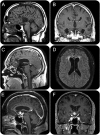Diagnosis and management of periodic hypothermia
- PMID: 29473588
- PMCID: PMC5765588
- DOI: 10.1212/01.CPJ.0000437350.47610.3a
Diagnosis and management of periodic hypothermia
Abstract
Hypothermia, defined as a core temperature below 35°C, can occur in a variety of clinical settings, including environmental exposure, shock, infection, metabolic disorders (such as hypothyroidism, adrenal insufficiency, and Wernicke encephalopathy), malnutrition, and alcohol or drug toxicity. Typically, hypothermia should resolve with treatment of the underlying disorder. However, in rare cases patients experience recurrent episodes of hypothermia in the context of a stereotyped syndrome due to a hypothalamic lesion, which can be either congenital or acquired. The episodes are characterized by progressive confusion and a decreased level of arousal, hypothermia, and eventual resolution with a return to baseline. Additional clinical findings during episodes may include diaphoresis, asterixis, bradycardia, and thrombocytopenia. These recurrent episodes represent periodic hypothermia.
Figures


References
-
- Darku B, Kalra P, Prasad C, Yadav R. Episodic hyperhidrosis with corpus callosum agenesis: a rare case of Shapiro syndrome. Neurol India. 2011;59:130–131. - PubMed
-
- LeWitt PA, Newman RP, Greenberg HS, Rocher LL, Calne DB, Ehrenkranz JR. Episodic hyperhidrosis, hypothermia, and agenesis of the corpus callosum. Neurology. 1983;33:1122–1129. - PubMed
-
- LeWitt P. Hyperhidrosis and hypothermia responsive to oxybutynin. Neurology. 1988;38:506–507. - PubMed
-
- Sanfield JA, Linares OA, Cahalan DD, Forrester JM, Halter JB, Rosen SG. Altered norepinephrine metabolism in Shapiro’s syndrome. Arch Neurol. 1989;46:53–57. - PubMed
-
- Shenoy C. Shapiro syndrome. QJM. 2008;101:61–62. - PubMed
LinkOut - more resources
Full Text Sources
Other Literature Sources
